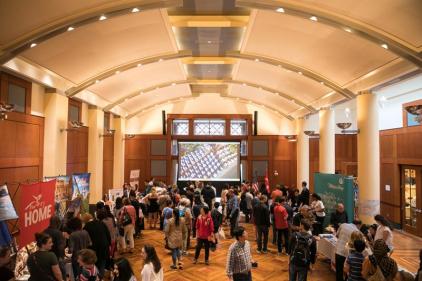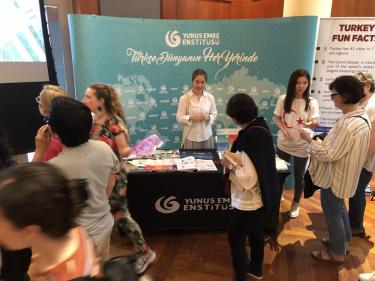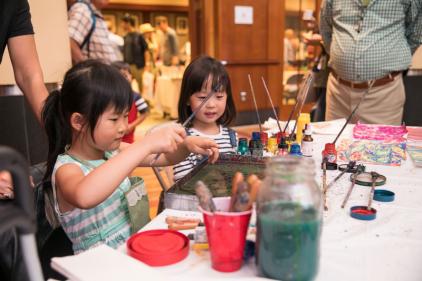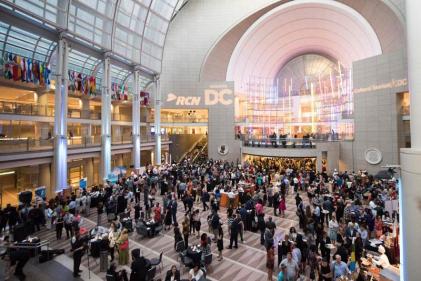Cultural Diplomacy through DC Passport
Cultural diplomacy has a significant positive correlation between soft power and public diplomacy. In order to enhance Turkey’s national image and soft power, Yunus Emre Institute in Washington D.C. dedicated to disseminating Turkish cultures and values through language instruction, culture-arts activities and other cultural interaction events.
On May 4, 2019. Yunus Emre Institute effectively increased the Turkish culture publicity by attending DC Passport in Washington D.C. “face to face communication has been the most effective tool for culture diplomacy” Yunus Emre Institute Public Relations Director Casey Kim said, “We want Turkish culture, whether ancient or modern, can be accurately perceived by the U.S. public.”
The Embassy of the Republic of Turkey held over 6,000 guests on the event day. Hospitality is a cornerstone of Turkish culture. Turkish people believe no matter where are you from, what language you speak, you are the guest sent by God. Before they enter the front gate, visitors to The Embassy of the Republic of Turkey were pleasantly surprised by a lively welcoming performance. While waiting for the line to enter the embassy, a unique welcoming performance by Turkish folk dancers. Turkey has a very ancient folk dance tradition, people dance at social occasions such as weddings, holidays or birthdays. The dancers who were wearing traditional festive costume performed several different dances: Zeybek, Horon, and Halay.
Inside the embassy, guests were traveling to Turkey as they experiencing its music, art, food, manufactured goods, and language. Children were curiously watching the ebru artist working on her masterpieces. Ebru is an art form from Central Anatolia region, it dates back to the Ottoman Empire at the beginning of the 16th century. Visitors were amazed at the artist floated different colors on the surface of the water, then used the awl to create the swirl and streaked patterns. After she has completed the painting process, the artist carefully placed a sheet of paper on the top of the water. When she removed it, the image completely transferred onto the paper. Here it is! A marble masterpiece is produced.
Language is the other effective tool of cultural diplomacy since it is the arena where cultural, historical, and social aspects of Turkish life have converged. Yunus Emre Institute highly recognized the cultural importance of language. While visitors exploring Turkish culture, Yunus Emre Institute associates were teaching short Turkish phrases to their guests, such as “Merhaba”, “Nasilsin”, and “Teşekkür Ederim.” Many kids were eager to practice their pre-learned Turkish with Yunus Emre Institute associates. Guests also learned about the summer Turkish class, culinary program, and other upcoming events of the Institute.
The other pleasant surprise for the visitors was an ancient bazaar was brought to the embassy! The world famous handmade carpets and rugs from Konya, souvenirs, and decorations made of copper, and handmade leather shoes from Gaziantep. Gaziantep is one of the southern cities in Turkey, and famous for its hand-stitched leather shoes known as Yemeni. These impossibly comfortable soft flat shoes are made from five types of leather, including water buffalo hide for the soles, and goatskin tops, and are stitched together with beeswax coated cotton threads. Visitors were able to find many valuable traditional handicrafts as souvenirs, these shops offered them a unique bazaar shopping experience.
A walk through the “Bazaar” is a journey amidst enchanting aromas. The tempting smell of Turkish sweets and coffee. A piece of Lokum with a cup of Turkish coffee brought the guests back to the Ottoman Empire time. Turkish dishes also provided in the Embassy, slices of marinated lamb on a tall vertical spit and grilled as it slowly turns, the guests were lining up for a taste of Doner Sandwich. It is made with slices of lamb, chopped onion, green pepper and tomato within a thin lavas bread. With the exotic atmosphere and the mouthwatering Turkish cuisine, visitors were immersing themselves in Turkish culture.
The vibrant culture, art pieces, language, and famous food arose many guests’ desire to explore this ancient country. Turkey Home, a project by the Ministry of Culture and Tourism, offered abundant information to the participants about famous tourist attractions in Turkey. The spellbinding Byzantine glory of the Aya Sofya, hot balloon ride in Cappadocia, and the natural wonders in Pamukkale. No matter they want to delve into history or laze on the beach, Turkey has attractions galore!
As the nation’s capital, our guests in Washington D.C. are from all over the world. Yunus Emre Institute international associates introduced Turkish culture in various languages, such as Korean, Mandarin, and Spanish. “Through Turkish dance, art, language, and cuisine, this event created a deep understanding of Turkish culture among over six thousand individuals today.” Yunus Emre Institute, Washington DC Branch Director Halid Bulut said, “cultural communication is the most effective tool to enhance the recognition and mutual understanding between Turkey and other nations. Our aim is to proudly introduce Turkish culture to the world.”












